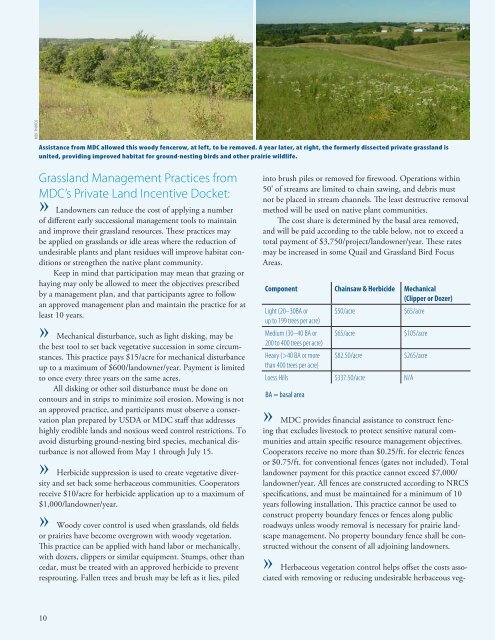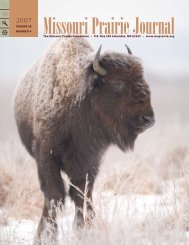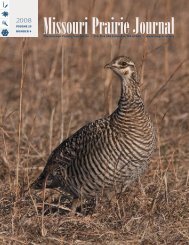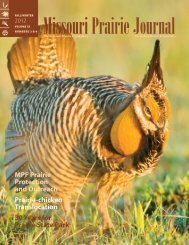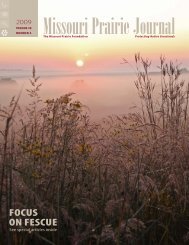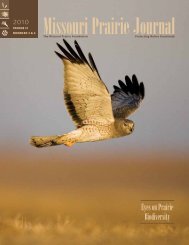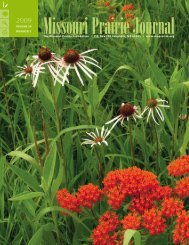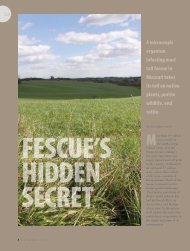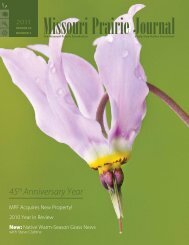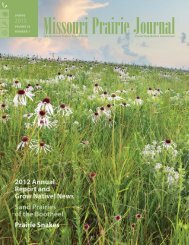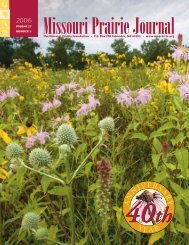Summer 2007: Volume 28, Number 3 - Missouri Prairie Foundation
Summer 2007: Volume 28, Number 3 - Missouri Prairie Foundation
Summer 2007: Volume 28, Number 3 - Missouri Prairie Foundation
- No tags were found...
You also want an ePaper? Increase the reach of your titles
YUMPU automatically turns print PDFs into web optimized ePapers that Google loves.
MDC PhotosAssistance from MDC allowed this woody fencerow, at left, to be removed. A year later, at right, the formerly dissected private grassland isunited, providing improved habitat for ground-nesting birds and other prairie wildlife.Grassland Management Practices fromMDC’s Private Land Incentive Docket:» Landowners can reduce the cost of applying a numberof different early successional management tools to maintainand improve their grassland resources. These practices maybe applied on grasslands or idle areas where the reduction ofundesirable plants and plant residues will improve habitat conditionsor strengthen the native plant community.Keep in mind that participation may mean that grazing orhaying may only be allowed to meet the objectives prescribedby a management plan, and that participants agree to followan approved management plan and maintain the practice for atleast 10 years.» Mechanical disturbance, such as light disking, may bethe best tool to set back vegetative succession in some circumstances.This practice pays $15/acre for mechanical disturbanceup to a maximum of $600/landowner/year. Payment is limitedto once every three years on the same acres.All disking or other soil disturbance must be done oncontours and in strips to minimize soil erosion. Mowing is notan approved practice, and participants must observe a conservationplan prepared by USDA or MDC staff that addresseshighly erodible lands and noxious weed control restrictions. Toavoid disturbing ground-nesting bird species, mechanical disturbanceis not allowed from May 1 through July 15.» Herbicide suppression is used to create vegetative diversityand set back some herbaceous communities. Cooperatorsreceive $10/acre for herbicide application up to a maximum of$1,000/landowner/year.» Woody cover control is used when grasslands, old fieldsor prairies have become overgrown with woody vegetation.This practice can be applied with hand labor or mechanically,with dozers, clippers or similar equipment. Stumps, other thancedar, must be treated with an approved herbicide to preventresprouting. Fallen trees and brush may be left as it lies, piledinto brush piles or removed for firewood. Operations within50' of streams are limited to chain sawing, and debris mustnot be placed in stream channels. The least destructive removalmethod will be used on native plant communities.The cost share is determined by the basal area removed,and will be paid according to the table below, not to exceed atotal payment of $3,750/project/landowner/year. These ratesmay be increased in some Quail and Grassland Bird FocusAreas.Component Chainsaw & Herbicide Mechanical(Clipper or Dozer)Light (20–30BA or$50/acre$65/acreup to 199 trees per acre)Medium (30–40 BA or $65/acre$105/acre200 to 400 trees per acre)Heavy (>40 BA or more $82.50/acre$265/acrethan 400 trees per acre)Loess Hills $337.50/acre N/ABA = basal area» MDC provides financial assistance to construct fencingthat excludes livestock to protect sensitive natural communitiesand attain specific resource management objectives.Cooperators receive no more than $0.25/ft. for electric fencesor $0.75/ft. for conventional fences (gates not included). Totallandowner payment for this practice cannot exceed $7,000/landowner/year. All fences are constructed according to NRCSspecifications, and must be maintained for a minimum of 10years following installation. This practice cannot be used toconstruct property boundary fences or fences along publicroadways unless woody removal is necessary for prairie landscapemanagement. No property boundary fence shall be constructedwithout the consent of all adjoining landowners.» Herbaceous vegetation control helps offset the costs associatedwith removing or reducing undesirable herbaceous veg-10


